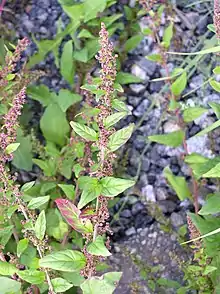Lipandra
Lipandra polysperma (Syn. Chenopodium polyspermum), common name manyseed goosefoot,[1] is the only species of the monotypic plant genus Lipandra from the subfamily Chenopodioideae of the family Amaranthaceae.
| Lipandra | |
|---|---|
 | |
| Manyseed goosefoot (Lipandra polysperma) | |
| Scientific classification | |
| Kingdom: | Plantae |
| Clade: | Tracheophytes |
| Clade: | Angiosperms |
| Clade: | Eudicots |
| Order: | Caryophyllales |
| Family: | Amaranthaceae |
| Subfamily: | Chenopodioideae |
| Tribe: | Atripliceae |
| Genus: | Lipandra Moq. |
| Species: | L. polysperma |
| Binomial name | |
| Lipandra polysperma | |
| Synonyms | |
| |
Description
Lipandra polysperma is a non-aromatic, glabrous annual herb. The stems grow erect to ascending or prostrate and are branched with usually alternate, basally sometimes nearly opposite branches. The alternate leaves consist of a petiole and a simple blade. The leaf blade is thin, ovate-elliptic, with entire margins.
The inflorescences consist of loose dichasia in the axils of leaf-like bracts, sometimes of more condensed glomerules of flowers arranged spicately. The flowers are bisexual or pistillate, with (4-) 5 nearly free perianth segments, 1-3 (-5) stamens and an ovary with 2 stigmas.
In fruit, perianth segments remain unchanged. The fruit has a membranous pericarp, which is free from the seed. The horizontally orientated seeds are compressed-globose. The brown to blackish seed coat is undulately striate.[2]
Distribution
Lipandra polysperma is distributed in most regions of Europe and in temperate Asia.[3] It is widely naturalized elsewhere, as in North America.[4]
Systematics
The species was first described in 1753 by Carl Linnaeus as Chenopodium polyspermum in Species Plantarum.[5] After phylogenetic research, Fuentes-Bazan et al. (2012) separated this species from genus Chenopodium that would otherwise have been polyphyletic. The genus Lipandra was first described by Alfred Moquin-Tandon in 1840 (in Chenopodearum monographica enumeratio, p. 19.), replacing an older illegitimate name: Christian Friedrich Lessing's genus Oligandra (1835, not the Asteraceae genus Oligandra from 1832) had only one species, Oligandra atriplicoides, that was soon considered identical with Chenopodium polyspermum.[2]
Lipandra polysperma belongs to the same tribe as Chenopodium, Tribus Atripliceae.[2]
Synonyms of genus Lipandra Moq.:[2]
- Oligandra Less. 1835 (nom illeg., non Less. 1832)
- Gandriloa Steud. (nom. illeg.)
- Oliganthera Endl. (nom. illeg.)
- Chenopodium [unranked] Polysperma Standl.
- Chenopodium subsect. Polysperma (Standl.) Kowal ex Mosyakin & Clemants
References
- "Chenopodium polyspermum". Natural Resources Conservation Service PLANTS Database. USDA. Retrieved 16 January 2016.
- Fuentes-Bazan, Susy; Uotila, Pertti; Borsch, Thomas (2012). "A novel phylogeny-based generic classification for Chenopodium sensu lato, and a tribal rearrangement of Chenopodioideae (Chenopodiaceae)". Willdenowia - Annals of the Botanic Garden and Botanical Museum Berlin-Dahlem. 42 (1): 14–15. doi:10.3372/wi42.42101. ISSN 0511-9618.
- "Lipandra polysperma". Germplasm Resources Information Network (GRIN). Agricultural Research Service (ARS), United States Department of Agriculture (USDA). Retrieved 2013-07-10.
- Distribution map for the northern hemisphere from: Eric Hultén, Magnus Fries: Atlas of North European vascular plants. 1986, ISBN 3-87429-263-0 at Den virtuella floran..
- Carl von Linné: Species Plantarum. Vol. 1, Impensis Laurentii Salvii, Holmiae 1753, p. 220
External links
| Wikimedia Commons has media related to Lipandra polysperma. |
| Wikispecies has information related to Lipandra polysperma. |
- Chenopodium polyspermum in Flora of North America